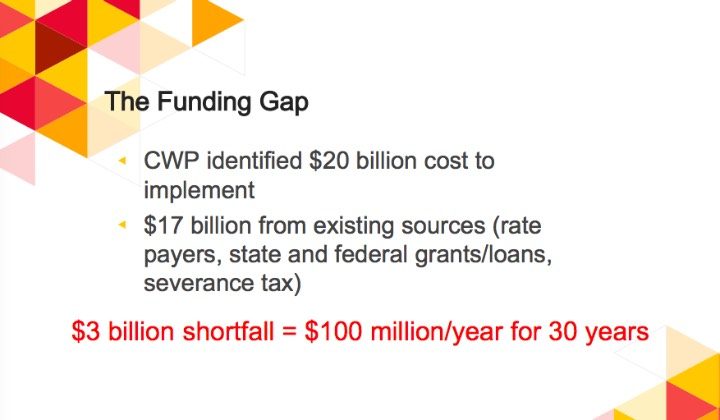Is Colorado’s Water Crisis a mythical animal? The folks behind the “For the Love of Colorado” election campaign in 2019 were working hard to convince us that the crisis was very real, and imminent.
And not too expensive, perhaps… all things considered.
The Colorado Water Plan, developed during the Hickenlooper administration and approved in 2015, has been described as “a new path to secure a water future that protects our state’s rivers; secures clean, safe, reliable drinking water for our communities; and preserves our agricultural heritage.”
In 2013, the full cost of Colorado Water Plan implementation was estimated, by plan advocates, at $20 billion.
Four years later, in 2017, Becky Mitchell, the newly appointed director of the state-funded Colorado Water Conservation Board, updated that estimate.
Mitchell put the anticipated price tag at $40 billion, and “maybe more.” Some $18 billion was likely to be paid by existing sources such as municipalities, water utilities, and ditch companies that deliver water to farms and ranches, she said. She described the remaining $22 billion as an “unmet funding need.”
“Cost projections have always been just estimates, and part of that is because not all the information is in,” Mitchell said. “What we’re already seeing, as folks are solidifying our numbers, is that it’s going to be more than earlier predictions.”
But two years later, in May 2019, the well-funded ‘For the Love of Colorado Coalition’ published a report quoting the estimated price of Plan implementation as “$20 billion”.
Apparently, the Steering Committee preferred the “$20 billion” estimate from 2013, over the updated $40 billion estimate from 2017.
2019 was something of a banner year, in terms of abundant water supplies in Colorado… unlike some of the more ‘drought-prone’ years we’ve experienced since 2001. In May, the US Department of Agriculture declared Colorado to be “99.99%” drought-free, an amazing turnaround from a year ago when 80% of the state was experiencing some level of dryness. In fact, it was the lowest amount of dryness in Colorado since the USDA Drought Monitor began tracking drought in 2000.
Only 0.01% of the state — about 8 square miles — was experiencing “abnormally dry conditions”… and Colorado’s snowpack was at 240% of normal, according to the Natural Resources Conservation Service.
Although the ‘For the Love of Colorado’ coalition and its 2019 marketing consultants, the Denver-based “Sukle” agency, might have wanted us to believe that ‘Math is really scary,’ the mathematics of water in 2019 was the opposite of frightening.
But… if, indeed, Colorado’s population is going to double by 2050, and if indeed our water supplies are not going to double, are there sensible (read: affordable) ways to address this dichotomy?
Are there sensible (read: affordable) ways that have been tried successfully… in other parts of the world, for example?
Or… will Colorado really get stuck with a $40 billion water infrastructure price tag?
As CWCB director Becky Mitchell had implied in 2017, much of the proposed “Colorado Water Plan” will be funded — if things go according to the plan — by local communities, through fees and taxes. Local municipalities and water districts might be handling $18 billion of the cost for proposed new dams, reservoirs and infrastructure, she suggested.
Which leads nicely into the current discussions at the San Juan Water Conservancy District regarding future investments by the taxpayer-funded district.
Note: I currently serve as an appointed volunteer on the San Juan Water Conservancy District, serving the taxpayers of Archuleta County. The following editorial expresses my own research and opinions, and does not necessarily reflect the opinions of any other SJWCD Board members, nor the decisions and policies of the SJWCD Board as a whole.
In the face of future uncertainty — not only about the cost of water projects, but also about the “diminishing supply of water” claimed in, for example, the ‘For the Love of Colorado’ marketing materials — our local San Juan Water Conservancy District (SJWCD) is committed to understanding various alternative approaches to ensuring adequate water supplies in Archuleta County, as the Board has created a ‘strategic plan’ to guide the district’s decisions over the next few years.
But the hot topic this winter is the West Fork Water Rights. A decision about retaining or abandoning those water rights must be made by the SJWCD board before the end of June.
You can download the 22-page draft “West Fork Water Rights Alternative Study” created by Lakewood-based Wilson Water Group; it is also available on the SJWCD website.
The most important findings of the report (in my humble opinion) were as follows:
1. The only reasonable location for a 24,000 acre-foot reservoir is in the Dry Gulch valley, on property already owned jointly by Pagosa Area Water and Sanitation District (PAWSD) and SJWCD.
2. PAWSD and SJWCD already hold water rights for an 11,000 acre-foot reservoir at that same location.
3. The future water demands, estimated through 2050, do not suggest the need for a reservoir larger than 11,000 acre-feet.
4. In fact, the estimates of future water demand for municipal and agricultural users do not appear to justify even an 11,000 acre-foot reservoir. But SJWCD might be able to justify a reservoir that large, if the water in the reservoir could be released — as needed — to enhance, specifically, environmental conditions and recreational uses in the San Juan River.
5. The West Fork and Dry Gulch water rights do not currently allow for the release of water for environmental or recreational needs. It might be possible to get the rights changed to allow for those uses.
A couple of important elements were not discussed in the draft report.
1. Money.
2. Voter approval.



